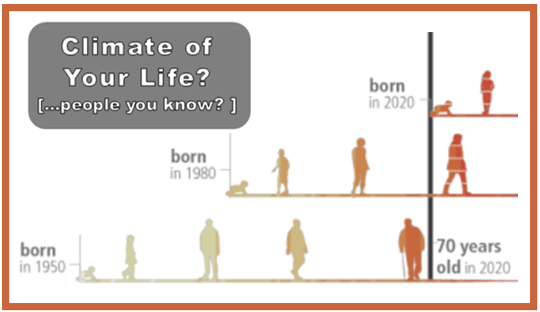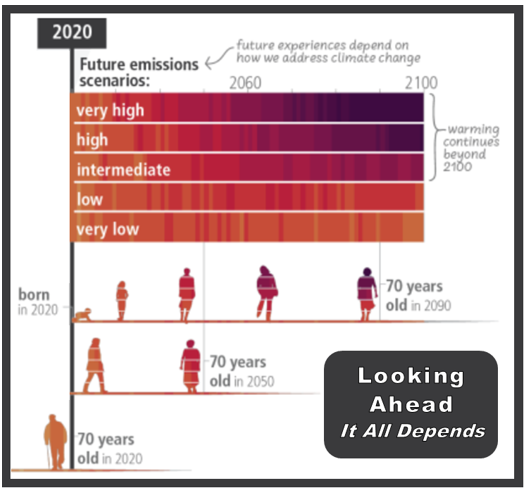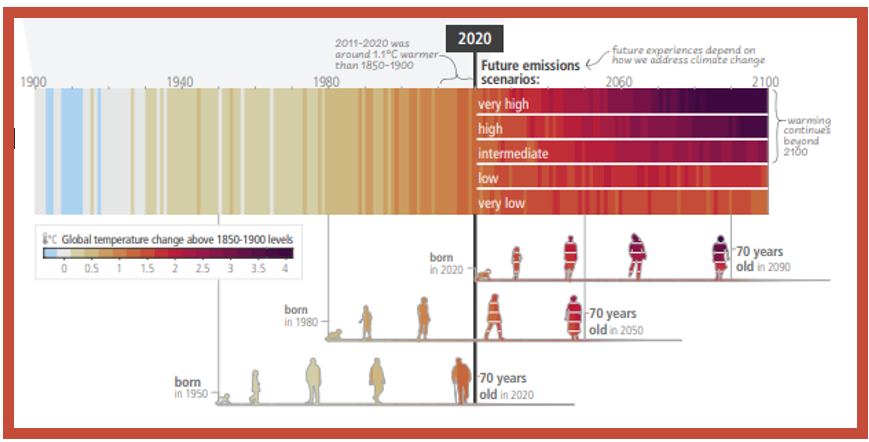| | | | More Climate Change Reports 2023 a record season for wildfires … Terrible inland flooding… Fastest-rising ocean level… Worst typhoon in decades… Most hazardous smoke duration… Hottest early June on record… Etc. Etc. The forewarnings keep coming. | |  | - If you are, then you are already well “up on” the IPCC’s most recent newsworthy account, the AR6 Synthesis Report: Climate Change 2023.
- If you are not, some pertinent commentary/links follow farther below. The global situation this latest report describes is forbidding, although not hopeless.
But… As with many a striking global report from the IPCC, this latest one (released in March) faded rather quickly from the media. Now June is here, and with it, more climate news. Examples: - Atmospheric smoke from Canadian forest fires exceeded many-decade levels and the fire season is forecast to yield alarmingly record-breaking acreage and duration. (CBC News, June 1, 2023)
- Current measurements of the heat-trapping carbon dioxide in Earth’s atmosphere underlying climate change have reached another new peak. (The annual warming-triggering data from Hawaii’s annually measured “spring peak” CO2 (Associated Press, June 5, 2023) shows no signs of slowing; rather, they are growing at a near-record fast pace.)
- Ocean temperatures… so uncommonly high that the “upper bound on the y axis on the graph” had to be extended to handle the recent data from the National Oceanic and Atmospheric Administration. (Los Angeles Times, June 13, 2023)
- The world endures the hottest early June on record. This has been the first time that the 1.5 degrees Celsius threshold (the level set by the 2015 Paris agreement) has been exceeded in June. (Bloomberg News, June 15, 2023)
To scientists, the planetary climate situation is dire, and certain requisites for action are plain to see. The IPCC has provided its deeply researched and data-heavy “synthesis report” in hopes of gaining useful action from policymakers. | | | | | | Background on the IPCC’s Reporting … The Intergovernmental Panel on Climate Change does a quite comprehensive scientific assessment every seven years or so (the next such report will likely be in 2027). By providing a 2023 summary document, the IPCC has aimed to give policymakers a high-level up-to-date understanding of climate change, note its impacts and future risks, and then highlight some options for addressing it (solutions). The major findings of the AR6 Synthesis report have been summarized by several different organizations. “…an undeniable scientific consensus about the urgency of the climate crisis, its primary causes, its current devastating impacts – especially on most climate vulnerable regions – and the irreversible harm that will occur if …” The IPCC’s bottom line. The situation is clear and imperative: There is insufficient global activism to reverse the deleterious changes, even as general trends are recognized. | | | | | | Conveying the Message The March 2023 assessment document was densely packed with both text and diagrams. In it, the IPCC offered politicians a somewhat focused approach. It concentrated on summarizing certain climate impacts of recent years, particularly the global temperature-rise and fossil fuel emissions. Key decisions about imparting recommendations to public policymakers had resulted in ... - a brusque and blunt manuscript (it was a mere 38 pages in length).
- a document that evidenced some regard for an adequate measure of “climate optimism”. (Too alarming communications can be as likely to shut down gainful action as to secure it.)
- a data-rich presentation with numerous charts and graphics for the reader to decipher.
And yet… - Measurements tend to wash over many people to little discernable effect. For them, data and statistics just don’t seem to make a useful dent, even when they are presented visually (in charts and graphs).
| | | | | | Bringing a Situation Home | |  | The larger “historical” portion of the illustration sits at the top of this bulletin. (The full graphic is presented farther below.) Whether viewed by policymakers or by members of the public, this visual appears to communicate urgency in a more meaningful fashion than most in the latest IPCC report. - The diagram shows colorfully the global climate changing since 1900 (up to 2020). One can note not only the rapidly changing colors, but also how this particular graphical presentation enables (perhaps tends to provoke) a more personal consideration of climate change.
- The IPCC is casting its recent climate data into human lifetimes, and thus any reader of the report can easily ponder in more personal terms what has already occurred (considering not only themselves, but also the people of varied ages they know).
| |  Consider what has transpired in earth’s climate across the lifetime of those born in 1950 (elderly now). Consider what has transpired in earth’s climate across the lifetime of those born in 1950 (elderly now).
How is that “reality” different from what the mature adult born in 1980 has experienced?
And then, there is the child born quite recently (in 2020). Most of that child’s life is yet to be lived. What lies ahead? | | By visually associating recent data with distinct lifetimes, the IPCC’s approach appears to “bring closer home” the evolving climatic situation. For many, this type of exposure to data can prove more meaningful than numbers and charts standing alone. Furthermore, this “up to the present” human framing sets the stage for more personal consideration of possible changes that now rest at the global doorstep. | |  Even the casual reader can ponder more concretely the situational options ahead, which the right-hand portion of the diagram depicts within segments of each human sketched. Even the casual reader can ponder more concretely the situational options ahead, which the right-hand portion of the diagram depicts within segments of each human sketched.
This diagram lays the groundwork for looking to the future in personal terms.
One can see the forecasted options in the righthand portion of the graphic. Those changes vary, depending very largely on human factors, on human activity starting right now.
One can ask oneself: “For that very young child, what lies ahead?” And… “What of other youth or adults that I know?” | | | | | | From the IPCC 2023 Report (and shown in full below). Succinct! But a picture able to pack a rather powerful personal punch. | |  |  | | | | | | | The Brights' Net
PO Box 163418 | Sacramento, California 95816-9418
916-737-5157 | the-brights@the-brights.net | | | | | | | |